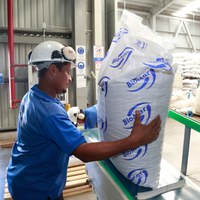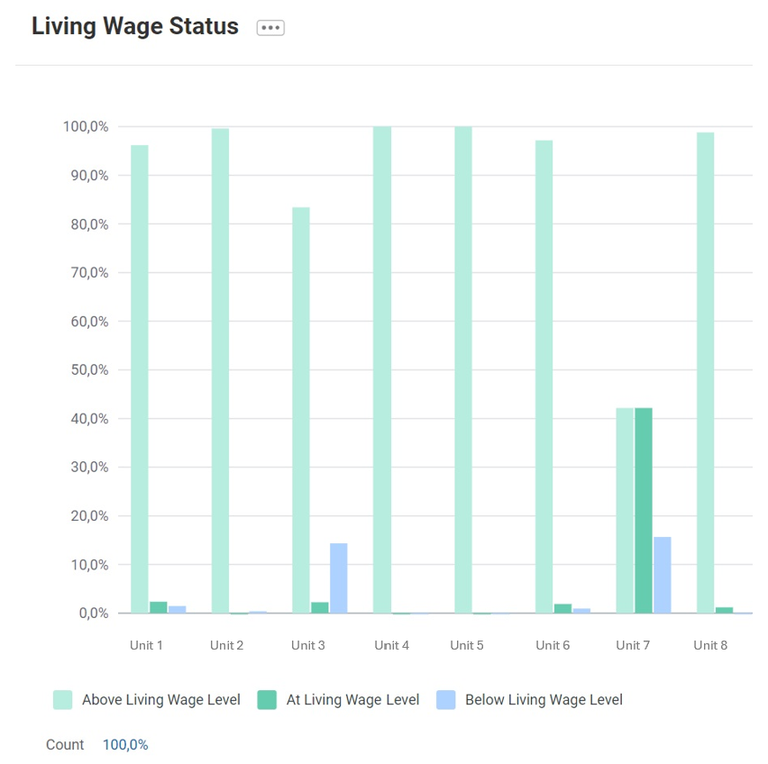BioMar Achieves 97% Living Wage Coverage, Calls on Industry to Follow Lead
“At BioMar we hope that by implementing living wages, there’s a ripple effect, and we inspire more of the industry as well as others in the value chain to follow suit. We believe it’s the right thing to put living wages on the agenda,” says Sif Rishoej, Vice President of People, Purpose and Communications at BioMar Group.
WageIndicator interviewed Ms. Sif Rishoej to discuss BioMar’s process of implementing living wages, the challenges they faced, and what motivates them to continue.
 |
 |
|
| Ms. Sif Rishoej |
As a prominent aquafeed company, BioMar places a strong emphasis on environmental sustainability. How does the concept of a living wage intersect with these efforts?
I think it's a really good question because, of course, naturally, and since the very beginning of our journey, you could say the environment has been at the forefront of what we have done. This means focusing on the natural environment, our planet, and the health of fish and shrimp, among other things. This has been a natural focus for our products and our clients.
However, results are created by people and as a company, we need to take responsibility for our own workforce in a conscious way by raising the bar. Additionally, we need to take responsibility for the workers in our supply chain and contribute to the communities around our operations.
We have always acted as a responsible company and provided good conditions for our workers. However, it is becoming increasingly important for us to measure whether what we are doing is actually right and to engage in dialogue when integrating new companies into our organisation. We need to discuss what constitutes responsible pay and employment practices. Working with living wages is an excellent tool to ensure we are having fact-based discussions about what constitutes a decent salary.
We are actively exploring how to take further responsibility for the social aspect of our operations. We have a dual focus on the planet and people, which is built into our policies and guidelines. In recent years, we are increasingly incorporating this dual focus in our KPIs.
Beyond advocating for a living wage, what other measurable people-focused interventions is BioMar implementing?
Yeah, we're currently working on our fair and equal pay initiative as well. It's still in progress, similar to our work with living wages. We're among other things developing a tool to measure how we're performing in terms of equal pay at different levels within the organization. Furthermore, we are working on ensuring that the working conditions are clearly documented, supporting the employees experience that labour rights are being protected. We are taking these initiatives because we believe it’s the right thing to do and because it enhances the employee experience of us as a responsible employer. Results are created by people, and human rights are fundamental prerequisites for creating results.
Personally, I am deeply passionate about our work in living wages. We hope that by implementing them, there’s a ripple effect, and more of our industry will follow suit. We believe that it is the right thing to do to put living wages on the agenda. Our experience working with sustainability has shown that when we introduce new initiatives, they often start resonating with other companies in our value chain. This effort isn't just about our own workers; it's about impacting the broader industry.
How have the managers in your supply chain spread across countries like China, Turkey and Vietnam to name a few, responding to BioMar’s intention of introducing living wages for all?
I think that once you explain what this is about, they really like the ideas. Our European managers tend to be less focused on this issue because they generally do not have workers earning below the living wage level. However, when you explain globally that this is about ensuring access to a decent life and that a living wage is measured based on concrete facts—such as the price of a liter of milk, bus fares, and other living expenses—they understand it better. (Biomar is using WageIndicator Living Wage data since April 2021)
When we discussed the concept in our Executive Committee a few years ago, it truly resonated with our CEO. As a global leader, who has been working across many geographies with very different working conditions, he understood its importance and it resonated with him deeply. We saw this as an ethical imperative and agreed that this is what we need to do.
Why did BioMar choose to work with WageIndicator?
We were looking into platforms that provide a clear understanding of the numbers and offer a solid framework for explaining and managing living wages within our organization. I particularly appreciated the detailed, regional-level data you provided. We often operate in rural environments, not capital cities, which presents challenges if we were to use a national living wage. The cost of living can vary significantly between rural areas and cities, such as in Costa Rica, where our factory is based in Cañas which has very different costs of living compared to San Jose. This regional detail was one of the reasons we chose your platform.
Another reason was the ease of getting started with your framework. Initially, we used your data in Excel to sample and assess our current standings. This allowed us to quickly engage with our organization, discussing whether the proposed salary levels made sense for local units. We didn't launch a massive project from the start; instead, we began by fostering dialogue and curiosity about living wages, rather than imposing them. This approach has been crucial because now different countries own their living wages.
How are you working towards implementing living wages, and how do you think it would benefit your organisation?
We have given all our managing directors across the world access to see their performance on living wages. They can view how many employees are above or below the living wage level. With the tool we've built, they can identify employees below the living wage, such as a warehouse operator, and understand the salary gap. They can assess whether the gap is significant and why it hasn't been addressed yet, empowering them to understand their data better.
A snapshot of BioMar’s Living Wage Tool that shows country directors how their region is doing in terms of living wages

We also discovered that two-thirds of our employees below the living wage level are new hires. This prompted a curious dialogue with our HR and general managers about why new hires start at lower salaries. We learned that we as an employer are prioritizing giving people without vocational education and relevant experience an opportunity to join BioMar. We want to maintain this practice; however, we are committed to accelerating the time it takes for an employee to be able to assume the position and thereby receive a living wage.
Our philosophy is to make our workforce more competent and valuable: both for us and for the community as a whole. If these employees leave, they bring higher skill levels to the broader society, making them more capable of taking on responsibilities in new jobs.
At BioMar, we have a 2030 ambition to enable 100,000 people by that year. This ambition involves educating, upskilling, and qualifying our own people for more advanced roles, but it also entails capability building in the local communities and among our stakeholders.
Did you encounter any challenges in the journey to implement living wages?
I think it's about introducing a concept that nobody has really heard about. Some of the work we are doing now with WageIndicator, like talking about living wages globally, is going to be helpful because people need to understand what it is. We have spent quite some time trying to explain this and why it's important. I don't think we're 100% there yet because it's a new concept, and people only have a limited bandwidth. That's one internal challenge we need to work with.
Additionally, taking a step ahead in sustainability areas, or ESG areas, whatever we call them, ahead of the competition is always challenging because you are potentially adding costs. This requires convincing senior management that this will bring value to us. Fortunately, at BioMar, we have a good tradition of recognizing the right thing to do and then doing it, trusting that we will create a ripple effect.
This visibility creates questions, which I welcome. For example, at a conference in Denmark, I was approached by another large international company. I showed them some of the work we were doing with the living wage tool, and they asked if we will be publishing this data as part of the new Corporate Social Reporting Directive (CSRD). I said yes, and they realised that it would be relevant for them to engage in dialogue about their living wage levels as well.
That is the whole idea—how do we ensure that more companies are inspired to develop their pay practices?
How is BioMar approaching the discussion on "adequate wages," the latest EU directive on minimum adequate wages to ensure fair working conditions?
I think it's a very good discussion to have. I believe we will see more and more regulations coming up, both at the EU level and from other parts of the world. We will see this trend globally. In general, we welcome new pay legislation because it challenges us as organizations to stay on our toes, ensure our employees are creating value, and build healthy structures.
The history of BioMar shows that this is not just words for us. Back in the seventies and eighties, there was a lot of focus on the environment in Scandinavian countries, leading to new legislation on environmental protection, especially for water bodies like creeks, lakes, seas, and oceans. This pushed us to create more sustainable fish feed products. Later, this turned out to be a competitive advantage in new markets because we knew how to operate sustainably. I believe having good conditions for workers is similar. We need to use this to develop our company.
Regarding adequate wages, I understand why some people find it challenging because higher standards in a country lead to higher wage expectations. However, I think the living wage level is a practical starting point for this discussion. Living wages are intuitively easy to understand—people need to afford basic necessities. Relative wages, on the other hand, are more complex. The higher the standard in a country, the higher we could expect the relative wage level will be. From a relative poverty perspective, this is correct because inadequate wages limit participation in many aspects of society. However, it's difficult to explain why someone in one country should have access to a certain level of living compared to another country. Having a uniform living wage standard globally is an easier first step to a global fair pay practice. However, as previously mentioned, we welcome the new legislation as an EU initiative.
Finally, what is BioMar’s overall vision with Living Wages?
As a global company, it's important to build a strong foundation for living wages across all our countries, sending a clear message that everyone should have a decent life. Enabling people to contribute to their societies, as part of our ambition, means they shouldn't have to work multiple jobs or excessive overtime just to pay their bills. This is crucial for societal health because it allows people to support their children's education, participate in community activities, and help others. If people need to work multiple jobs, it undermines the growth of local communities. This foundation is crucial and will remain our focus.
May, 2024
